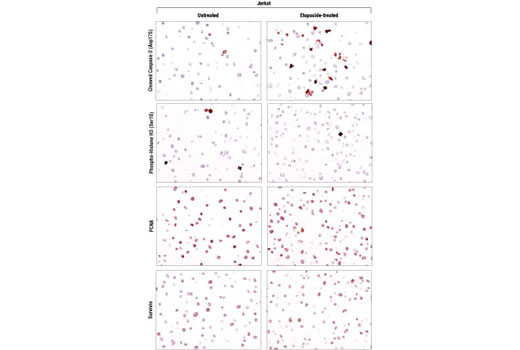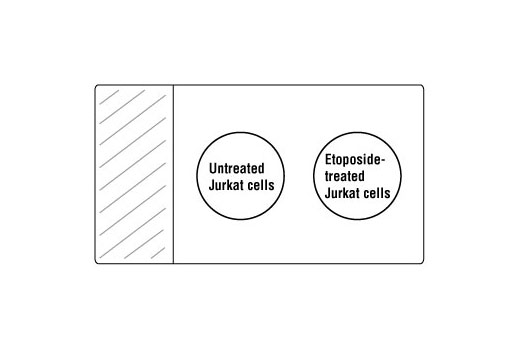| Kit Includes | Quantity | Antigen Retrieval / Diluent | Isotype |
|---|---|---|---|
| Cleaved Caspase-3 (Asp175) Antibody #9661 | 40 µl | Citrate / SignalStain® Antibody Diluent #8112 | |
| Phospho-Histone H3 (Ser10) Antibody #9701 | 40 µl | Citrate / SignalStain® Antibody Diluent #8112 | |
| PCNA (PC10) Mouse mAb #2586 | 40 µl | Citrate / SignalStain® Antibody Diluent #8112 | Mouse IgG2a |
| Survivin (71G4B7) Rabbit mAb #2808 | 40 µl | Citrate / SignalStain® Antibody Diluent #8112 | Rabbit IgG |
| *SignalStain® Antibody Diluent #8112 | 25 ml | ||
| †SignalSlide® Cleaved Caspase-3 (Asp175) IHC Controls #8104 | 1 Pack |
*SignalStain® Antibody Diluent is supplied as a working solution and should be stored at 4ºC (packaged separately).
†Control slides should be stored at 4ºC (packaged separately).
IHC-P
#P68431, #P12004, #P42574, #O15392
8350, 5111, 836, 332
Product Information
Storage
Specificity / Sensitivity
Source / Purification
Monoclonal antibody is produced by immunizing animals with a recombinant Protein A-PCNA fusion protein, or with a synthetic peptide corresponding to residues surrounding Cys60 of human Survivin. Polyclonal antibodies are produced by immunizing animals with a synthetic phosphopeptide corresponding to residues surrounding Ser10 of human histone H3, or with a synthetic peptide surrounding amino-terminal residues adjacent to Asp175 of human caspase-3. Antibodies are purified by protein A and peptide affinity chromatography.
Product Description
Background
Caspase-3 (CPP-32, Apoptain, Yama, SCA-1) is a critical executioner of apoptosis, as it is either partially or totally responsible for the proteolytic cleavage of many key proteins such as the nuclear enzyme poly (ADP-ribose) polymerase (PARP) (1). Activation of caspase-3 requires proteolytic processing of its inactive zymogen into activated p17 and p12 fragments (2). Survivin is a 16 kDa anti-apoptotic protein highly expressed during fetal development and cancer cell malignancy (3). Survivin binds and inhibits caspase-3, controlling the checkpoint in the G2/M-phase of the cell cycle through inhibiting apoptosis and promoting cell division (4,5). Proliferating cell nuclear antigen (PCNA) is a member of the DNA sliding clamp family of proteins that assist in DNA replication (6). Multiple proteins involved in DNA replication, DNA repair, and cell cycle control bind to PCNA rather than directly associating with DNA, thus facilitating fast processing of DNA (reviewed in 7). PCNA protein expression is a well-accepted marker of proliferation, and PCNA (PC10) Mouse mAb has been used to assess PCNA levels in hundreds of scientific studies. Histone H3, H2A, H2B, and H4 make up the core histones of the nucleosome. In response to various stimuli, the amino-terminal tails of core histones undergo various post-translational modifications, including acetylation, phosphorylation, methylation and ubiquitination, which affect the accessibility of chromatin to transcription factors (8). Phosphorylation of Histone H3 at Ser10, Ser28 and Thr11 of histone H3 is tightly correlated with chromosome condensation during both mitosis and meiosis (9-11).
- Fernandes-Alnemri, T. et al. (1994) J Biol Chem 269, 30761-4.
- Nicholson, D.W. et al. (1995) Nature 376, 37-43.
- Reed, J.C. and Reed, S.I. (1999) Nat Cell Biol 1, E199-200.
- Li, F. et al. (1998) Nature 396, 580-4.
- Li, F. et al. (1999) Nat Cell Biol 1, 461-6.
- Kelman, Z. and O'Donnell, M. (1995) Nucleic Acids Res 23, 3613-20.
- Maga, G. and Hubscher, U. (2003) J Cell Sci 116, 3051-60.
- Jaskelioff, M. and Peterson, C.L. (2003) Nat Cell Biol 5, 395-9.
- Hendzel, M.J. et al. (1997) Chromosoma 106, 348-60.
- Goto, H. et al. (1999) J Biol Chem 274, 25543-9.
- Preuss, U. et al. (2003) Nucleic Acids Res 31, 878-85.
Species Reactivity
Species reactivity is determined by testing in at least one approved application (e.g., western blot).
Applications Key
IHC-P: Immunohistochemistry (Paraffin)
Cross-Reactivity Key
H: human M: mouse R: rat Hm: hamster Mk: monkey Vir: virus Mi: mink C: chicken Dm: D. melanogaster X: Xenopus Z: zebrafish B: bovine Dg: dog Pg: pig Sc: S. cerevisiae Ce: C. elegans Hr: horse GP: Guinea Pig Rab: rabbit All: all species expected
Trademarks and Patents
使用に関する制限
法的な権限を与えられたCSTの担当者が署名した書面によって別途明示的に合意された場合を除き、 CST、その関連会社または代理店が提供する製品には以下の条件が適用されます。お客様が定める条件でここに定められた条件に含まれるものを超えるもの、 または、ここに定められた条件と異なるものは、法的な権限を与えられたCSTの担当者が別途書面にて受諾した場合を除き、拒絶され、 いかなる効力も効果も有しません。
研究専用 (For Research Use Only) またはこれに類似する表示がされた製品は、 いかなる目的についても FDA または外国もしくは国内のその他の規制機関により承認、認可または許可を受けていません。 お客様は製品を診断もしくは治療目的で使用してはならず、また、製品に表示された内容に違反する方法で使用してはなりません。 CST が販売または使用許諾する製品は、エンドユーザーであるお客様に対し、使途を研究および開発のみに限定して提供されるものです。 診断、予防もしくは治療目的で製品を使用することまたは製品を再販売 (単独であるか他の製品等の一部であるかを問いません) もしくはその他の商業的利用の目的で購入することについては、CST から別途許諾を得る必要があります。 お客様は以下の事項を遵守しなければなりません。(a) CST の製品 (単独であるか他の資材と一緒であるかを問いません) を販売、使用許諾、貸与、寄付もしくはその他の態様で第三者に譲渡したり使用させたりしてはなりません。また、商用の製品を製造するために CST の製品を使用してはなりません。(b) 複製、改変、リバースエンジニアリング、逆コンパイル、 分解または他の方法により製品の構造または技術を解明しようとしてはなりません。また、 CST の製品またはサービスと競合する製品またはサービスを開発する目的で CST の製品を使用してはなりません。(c) CST の製品の商標、商号、ロゴ、特許または著作権に関する通知または表示を除去したり改変したりしてはなりません。(d) CST の製品をCST 製品販売条件(CST’s Product Terms of Sale) および該当する書面のみに従って使用しなければなりません。(e) CST の製品に関連してお客様が使用する第三者の製品またはサービスに関する使用許諾条件、 サービス提供条件またはこれに類する合意事項を遵守しなければなりません。

